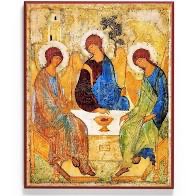As a good Baptist, I didn’t have anything to do with religious images growing up. We had no images in our place of worship, not even a cross. I think we were afraid that we might violate the “graven image” commandment (Exodus 20:4, KJV).
When I was a student at Southwestern Seminary, I had missions class in a large, ornate room next to the Chapel. During our time in Fort Worth, we would take visitors downtown to a storefront building to see a display of wax figures depicting DaVinci’s Last Supper. Only later was I told that a wealthy benefactor had commissioned this as a gift to the seminary to be displayed in that large room adjacent to the Chapel. It was meant to attract visitors to the seminary; however, the more conservative brethren in Texas objected to these “graven images” so they went into the exile downtown. (If this story is apocryphal, someone please correct me.) I think Jesus and the disciples eventually ended up at the (now defunct) Radio and Television Commission building. I have wondered from time to time where the next stop was for this migrating group.
I believe that it was Molly Marshall who helped me to understand the value of religious imagery. She was very taken with an icon referred to as the Old Testament Trinity. Painted by Russian artist Andrei Rublev in the 15th Century, the image depicts the three angels who visited Abraham (Genesis 18:1-8) and to whom he showed hospitality. Many interpret it as an icon depicting the Holy Trinity. Molly used the image in her annual Christmas publication from Central Seminary and commented on its symbolism often.
To those not familiar with the term, an icon is a religious work of art, most commonly a painting, used in Orthodox and Catholic churches as a focus for prayer and devotion. Those who use them are not worshipping the images but using them to facilitate worship, much as one might meditate on a verse of scripture.
I now have three icons in my office. The “Old Testament Trinity” was the first icon that I purchased while on a visit to the bookstore at Conception Abbey in Missouri while on a seminary retreat. Since then, I have acquired two more.
One is of Barnabas, one of my favorite people in the New Testament, who was generous, encouraging, and responsive to the Spirit of God. My appreciation of him is expressed in the use of his name in the title of this blog.
Another is of Saint Patrick, the patron saint of Ireland. George Hunter’s The Celtic Way of Evangelism helped me to understand the missional impact of Patrick (or at least of those who were his spiritual descendants). For me, he symbolizes creativity and innovation on behalf of the Reign of God.
Do I worship these icons? No. Does their presence in my office remind me that we celebrate the work of God with our eyes as well as our ears and mouths? Yes. I am grateful for the skilled artisans who provided these images, for the heritage that provides them for us, and for the richness of our Christian tradition.



Comments